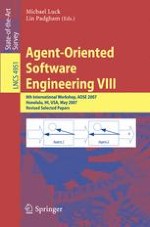Software architectures that contain many dynamically interacting components, each with its own thread of control, engaging in complex coordination protocols, are difficult to correctly and efficiently engineer. Agent-oriented modelling techniques are important for the design and development of such applications. This book provides a diverse and interesting overview of the work that is currently being undertaken by a growing number of researchers in the area of Agent-Oriented Software Engineering.
This volume constitutes the thoroughly refereed proceedings of the 8th International Workshop on Agent-Oriented Software Engineering, AOSE 2007, held in Honolulu, Hawaii in May 2007 as part of AAMAS 2007. The 16 revised full papers were carefully selected from numerous submissions during two rounds of reviewing and improvement. The volume contains the papers presented at the workshop, together with papers resulting from discussions on tools and platforms. The papers have been organized into four sections on: methodology and processes, interacting heterogeneous agents, system development issues, and tools and case studies.
